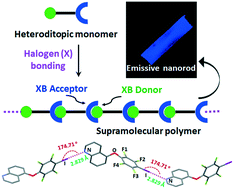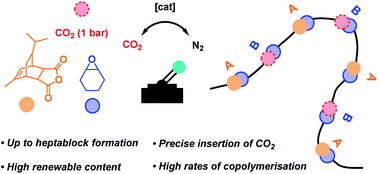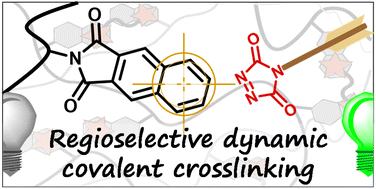Themed collection Chemistry of polymers - Chemical Science symposium collection

Using precision polymer chemistry for plastics traceability and governance
Resolving the anonymity of plastic materials is critical for safeguarding the well-being of our natural environments and human health.

Polym. Chem., 2022,13, 6082-6090
https://doi.org/10.1039/D2PY01180H
Reconsidering terms for mechanisms of polymer growth: the “step-growth” and “chain-growth” dilemma
Terms used for mechanisms of polymer growth are varied and problematic; we detail here our concerns with the terms “step-growth” and “chain-growth.” Ultimately, we seek terms that are simple, accurate, and attractive to the polymer community.

Polym. Chem., 2022,13, 2262-2270
https://doi.org/10.1039/D2PY00086E
Enlightening advances in polymer bioconjugate chemistry: light-based techniques for grafting to and from biomacromolecules
Light-driven synthetic techniques have revolutionized polymer–biomacromolecule conjugation. This Perspective discusses the benefits of photochemistry for polymer–protein ligation and considerations when designing a new light-driven conjugation approach.

Chem. Sci., 2020,11, 5142-5156
https://doi.org/10.1039/D0SC01544J
Gaining control over conjugated polymer morphology to improve the performance of organic electronics
Conjugated polymer (CP) microstructure plays a crucial role in determining the characteristics of a target device. Here, we provide an overview of the key aspects of the CP microstructure-property relationship carried out in our group.

Chem. Commun., 2022,58, 6982-6997
https://doi.org/10.1039/D2CC01430K
Poly(vinylpyridine)-containing block copolymers for smart, multicompartment particles
This review summarizes recent progress in smart multicompartment particles based on PVP-containing block copolymers, including their preparation strategies, properties, and applications.

Polym. Chem., 2022,13, 2570-2588
https://doi.org/10.1039/D2PY00150K
RAFT step-growth polymerization of bis-acrylamides and their facile degradation
Demonstrated is the successful A2 + B2 RAFT step-growth polymerization of bis-acrylamides. The synthesized poly(acrylamides) can be degraded by simply adding excess ethanolamine or PBu3.

Polym. Chem., 2023,14, 2592-2598
https://doi.org/10.1039/D3PY00379E
Structural influence on stimuli-responsive halogen-bonded luminescent supramolecular polymers from heteroditopic isomers
Halogen-bonded (XB) supramolecular polymers from two heteroditopic, emissive hydroxyquinoline-based structural isomers displayed distinctly different crystal packing & stimuli-responsive morphologies, due to the varying XB directionality & strength.

CrystEngComm, 2021,23, 1695-1699
https://doi.org/10.1039/D1CE00101A
Alternatives to fluorinated binders: recyclable copolyester/carbonate electrolytes for high-capacity solid composite cathodes
A series of poly(ester-b-carbonate) electrolytes are prepared by a one-pot procedure and structure–property relationships are observed. The polymer was used as a composite cathode binder with excellent discharge capacity and capacity retention.

Chem. Sci., 2024,15, 2371-2379
https://doi.org/10.1039/D3SC05105F
Oxidization enhances type I ROS generation of AIE-active zwitterionic photosensitizers for photodynamic killing of drug-resistant bacteria
An efficient type I zwitterionic photosensitizer MPD-O was constructed by an oxidization strategy, providing a new guideline for the development of AIE-active type I photosensitizers.

Chem. Sci., 2023,14, 4863-4871
https://doi.org/10.1039/D3SC00980G
Degradable polyisoprene by radical ring-opening polymerization and application to polymer prodrug nanoparticles
Radical ring-opening copolymerization of isoprene and dibenzo[c,e]oxepane-5-thione via free-radical and controlled radical polymerizations led to degradable polyisoprene under basic, oxidative and physiological conditions with application to prodrug nanoparticles.

Chem. Sci., 2023,14, 3311-3325
https://doi.org/10.1039/D2SC05316K
Open-air green-light-driven ATRP enabled by dual photoredox/copper catalysis
Fully oxygen-tolerant photoinduced atom transfer radical polymerization (photo-ATRP) allowed the synthesis of well-defined polymers using a Cu catalyst and eosin Y at ppm levels in both aqueous and organic media.

Chem. Sci., 2022,13, 11540-11550
https://doi.org/10.1039/D2SC04210J
Silica nanoparticle-loaded thermoresponsive block copolymer vesicles: a new post-polymerization encapsulation strategy and thermally triggered release
A loading efficiency of up to 86% is achieved for silica nanoparticles encapsulated within crosslinkable redox-sensitive thermoresponsive diblock copolymer vesicles in water at 50 °C; triggered release is also demonstrated for this system.

Chem. Sci., 2022,13, 9569-9579
https://doi.org/10.1039/D2SC02103J
Chain end-group selectivity using an organometallic Al(III)/K(I) ring-opening copolymerization catalyst delivers high molar mass, monodisperse polyesters
A heterodinuclear Al(III)/K(I) organometallic ring-opening copolymerization catalyst shows exceptional rates, end-group selectivity and good loading tolerance to deliver monodisperse polyesters with molar masses up to 91 kg mol−1.

Chem. Sci., 2022,13, 8543-8549
https://doi.org/10.1039/D2SC02752F
Polymerization-induced self-assembly and disassembly during the synthesis of thermoresponsive ABC triblock copolymer nano-objects in aqueous solution
Chain extension of linear AB diblock copolymer vesicles by seeded RAFT aqueous dispersion polymerization using a hydrophilic monomer C leads to polymerization-induced disassembly to form lower-order thermoresponsive ABC triblock copolymer nano-objects.

Chem. Sci., 2022,13, 7295-7303
https://doi.org/10.1039/D2SC01611G
Dual electrochemical and chemical control in atom transfer radical polymerization with copper electrodes
The use of a Cu cathode in eATRP allows exploiting the synergistic effect between electrochemical and chemical stimuli to halt or accelerate polymerizations, reduce energy consumption and achieve control in challenging systems.

Chem. Sci., 2022,13, 6008-6018
https://doi.org/10.1039/D2SC01982E
A cell membrane-targeting AIE photosensitizer as a necroptosis inducer for boosting cancer theranostics
A membrane-targeting photosensitizer TBMPEI with AIE properties was synthesized via a new acceptor, and it was utilized as a necroptosis inducer during imaging-guided photodynamic therapy.

Chem. Sci., 2022,13, 5929-5937
https://doi.org/10.1039/D2SC01260J
Mg(II) heterodinuclear catalysts delivering carbon dioxide derived multi-block polymers
Carbon dioxide-based multiblock polymers are synthesised, in one-pot, from a mixture of monomers using a highly selective and active heterodinuclear Co(II)Mg(II) catalyst.

Chem. Sci., 2021,12, 12315-12325
https://doi.org/10.1039/D1SC03856G
Direct introduction of nitrogen and oxygen functionality with spatial control using copper catalysis
Synthetic chemists have spent considerable effort optimizing the synthesis of nitrogen and oxygen containing compounds through a number of methods; however, direct introduction of N- and O-functionality remains challenging.

Chem. Sci., 2018,9, 8748-8752
https://doi.org/10.1039/C8SC03288B
Enhancement of CO2 binding and mechanical properties upon diamine functionalization of M2(dobpdc) metal–organic frameworks
We predict that the orientationally-averaged Young's modulus of mmen–Zn2(dobpdc) increases by 112% compared to Zn2(dobpdc), a remarkable increase.

Chem. Sci., 2018,9, 5197-5206
https://doi.org/10.1039/C7SC05217K
Economical synthesis of functional aromatic polythioamides from KOH-assisted multicomponent polymerizations of sulfur, aromatic diamines and dialdehydes
A series of aromatic polythioamides with high gold extraction efficiency and high refractive index have been synthesized through the KOH-assisted multicomponent polymerization of elemental sulfur, aromatic diamines and aromatic dialdehydes.

Polym. Chem., 2023,14, 2617-2623
https://doi.org/10.1039/D2PY01560A
Regioselective photocycloaddition for light-stabilised dynamic materials design
In this contribution, the influence of regioisomerism in covalent dynamic polymer materials is discussed and highlighted for light-stabilised dynamic materials, which motivated the development of a completely regioselective bonding/debonding system.

Polym. Chem., 2023,14, 1554-1566
https://doi.org/10.1039/D3PY00027C
Oligo(ethylene glycol)-incorporated hole transporting polymers for efficient and stable inverted perovskite solar cells
We develop a series of poly(triarylamine)-based polymers with hydrophilic OEG side chains. The DEG-PTAA-based perovskite solar cell shows the highest efficiency of 22.26% with superior operational stability to the other devices.

J. Mater. Chem. A, 2023,11, 6615-6624
https://doi.org/10.1039/D3TA00633F
Degradable vinyl polymer particles by radical aqueous emulsion copolymerization of methyl methacrylate and 5,6-benzo-2-methylene-1,3-dioxepane
Aqueous emulsion copolymerization of methyl methacrylate (MMA) and 5,6-benzo-2-methylene-1,3-dioxepane (BMDO) leads to stable particles of PMMA bearing in-chain ester units that can be cleaved under basic conditions.

Polym. Chem., 2023,14, 1224-1231
https://doi.org/10.1039/D3PY00040K
4D printing of light activated shape memory polymers with organic dyes
An ink based on azodyes is presented, allowing fabrication of light activatable 4D shape memory geometries with spatiotemporal response control.

Mol. Syst. Des. Eng., 2023,8, 323-329
https://doi.org/10.1039/D2ME00201A
Aqueous seeded RAFT polymerization for the preparation of self-assemblies containing nucleobase analogues
Aqueous formulations of self-assemblies containing the nucleobase analogue 2,6-diacylaminopyridine have been obtained by seeded RAFT polymerization in water with different morphologies depending on the polymerization conditions.

Polym. Chem., 2023,14, 71-80
https://doi.org/10.1039/D2PY01250B
Reverse sequence polymerization-induced self-assembly in aqueous media: a counter-intuitive approach to sterically-stabilized diblock copolymer nano-objects
A 500 nm charge-stabilized latex is converted into 40 nm sterically-stabilized nanoparticles via reverse sequence polymerization-induced self-assembly (PISA).

Polym. Chem., 2022,13, 5980-5992
https://doi.org/10.1039/D2PY01064J
Effect of halogen and solvent on iron-catalyzed atom transfer radical polymerization
Efficient exchange of Br in iron-catalyzed ATRP in anisole provided well-controlled polymers with low dispersity as opposed to the Cl-based initiating system, which resulted in large dispersities due to the slower activation/deactivation with Cl.

Polym. Chem., 2022,13, 1059-1066
https://doi.org/10.1039/D1PY01601F
The role of anions in light-driven conductivity in diarylethene-containing polymeric ionic liquids
The role of anion character in the photostationary state, magnitude of conductivity, and light-responsive properties of diarylethene-containing polymeric ionic liquids was investigated.

Polym. Chem., 2021,12, 719-724
https://doi.org/10.1039/D0PY01603A
Towards nanoparticles with site-specific degradability by ring-opening copolymerization induced self-assembly in organic medium
Radical ring-opening copolymerization-induced self-assembly (rROPISA) was successfully applied to the synthesis of core-, surface- or surface plus core-degradable nanoparticles in heptane, leading to site-specific degradability by rROPISA.

Polym. Chem., 2021,12, 594-607
https://doi.org/10.1039/D0PY01425G
Combination of guanidinium and quaternary ammonium polymers with distinctive antimicrobial mechanisms achieving a synergistic antimicrobial effect
Synergistic killing of Gram negative bacteria by polymers that disrupt bacterial membranes and translocate and precipitate cytosolic proteins and nucleic acids.

Biomater. Sci., 2020,8, 6920-6929
https://doi.org/10.1039/D0BM00752H
Formation of bis-benzimidazole and bis-benzoxazole through organocatalytic depolymerization of poly(ethylene terephthalate) and its mechanism
One-pot syntheses of bis-benzimidazole and bis-benzoxazole from poly(ethylene terephthalate) waste bottles were successful through two-step nucleophilic attacks promoted by TBD.

Polym. Chem., 2020,11, 4904-4913
https://doi.org/10.1039/D0PY00436G
Supramolecularly cross-linked amphiphilic block copolymer assembly by the dipolar interaction of a merocyanine dye
Dipolar interaction driven dimerization of a merocyanine (MC) dye has been exploited to achieve non-covalently crosslinked stable micelles in water and reverse micelles in toluene with emissive properties from a MC-pendant amphiphilic block copolymer.

Polym. Chem., 2020,11, 695-703
https://doi.org/10.1039/C9PY01492F
Hierarchical patterns with sub-20 nm pattern fidelity via block copolymer self-assembly and soft nanotransfer printing
We describe the development of a technique to transfer micrometer patterns of organic thin films with sub-50 nm edge resolution and sub-20 nm pattern fidelity.

Polym. Chem., 2019,10, 3194-3200
https://doi.org/10.1039/C9PY00335E
A focus on how latent “codons” are unravelled in synthetic copolymers
We explore and comment on a key development using advanced mass spectrometric methods coupled with advanced algorithmic learning that can assist in analysing complex copolymers.

Chem. Sci., 2023,14, 5825-5826
https://doi.org/10.1039/D3SC90087H
About this collection
The chemistry of polymers is the theme of this years’ Chemical Science symposium. We are excited to welcome the community back to our home in London, and virtually, for the fifth symposium in this series. To celebrate, we have selected articles recently published by the speakers and committee to showcase their work in RSC journals.
We hope you enjoy reading these articles and look forward to welcoming you to London either in-person or virtually in October!